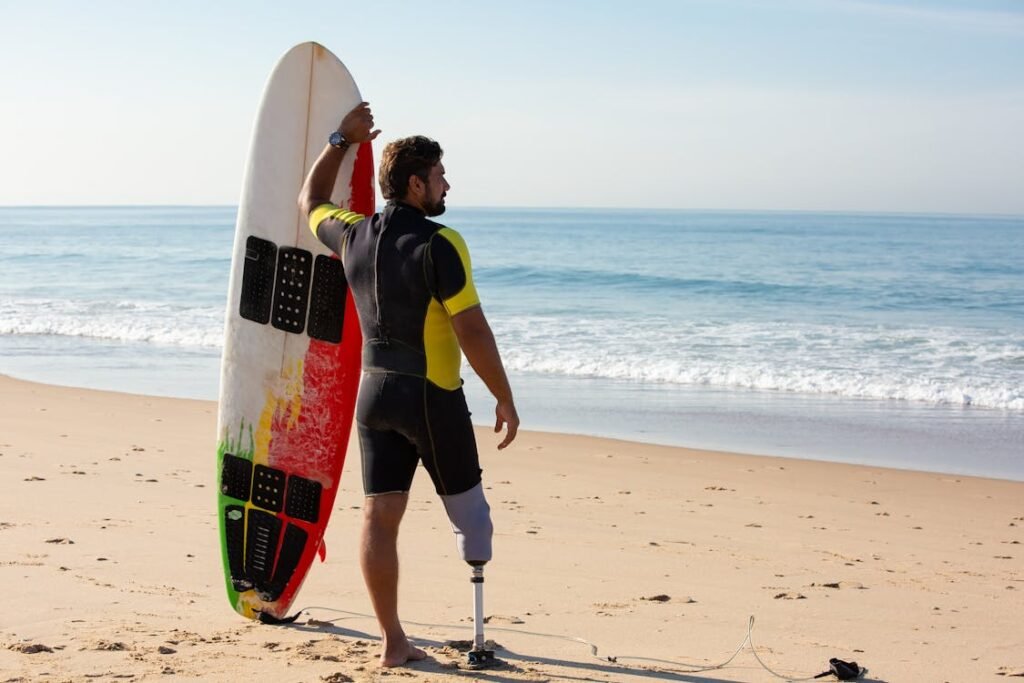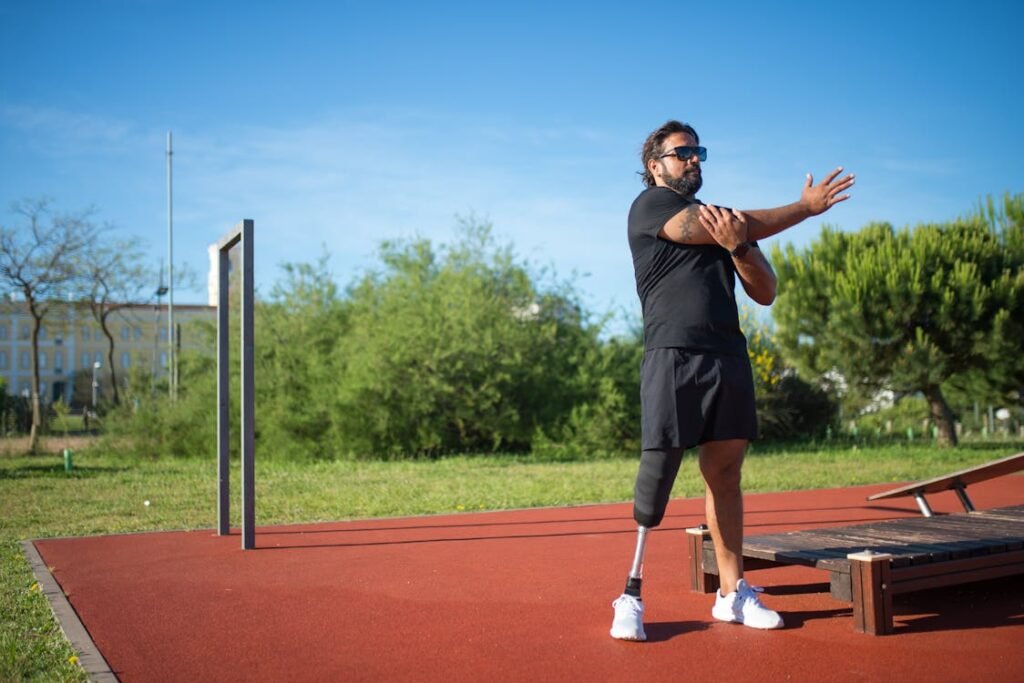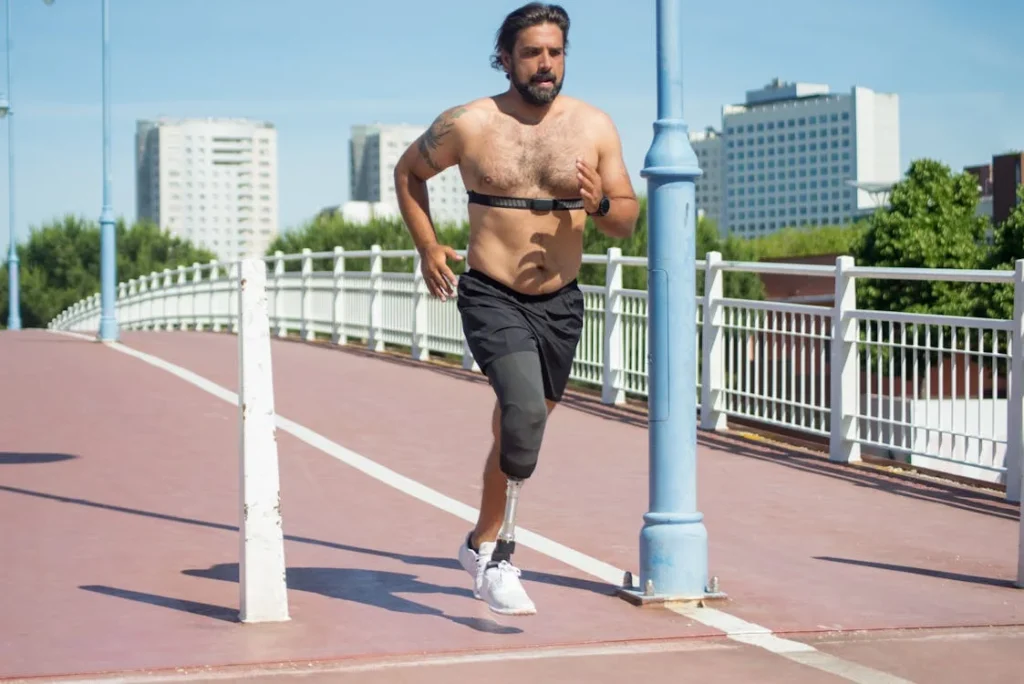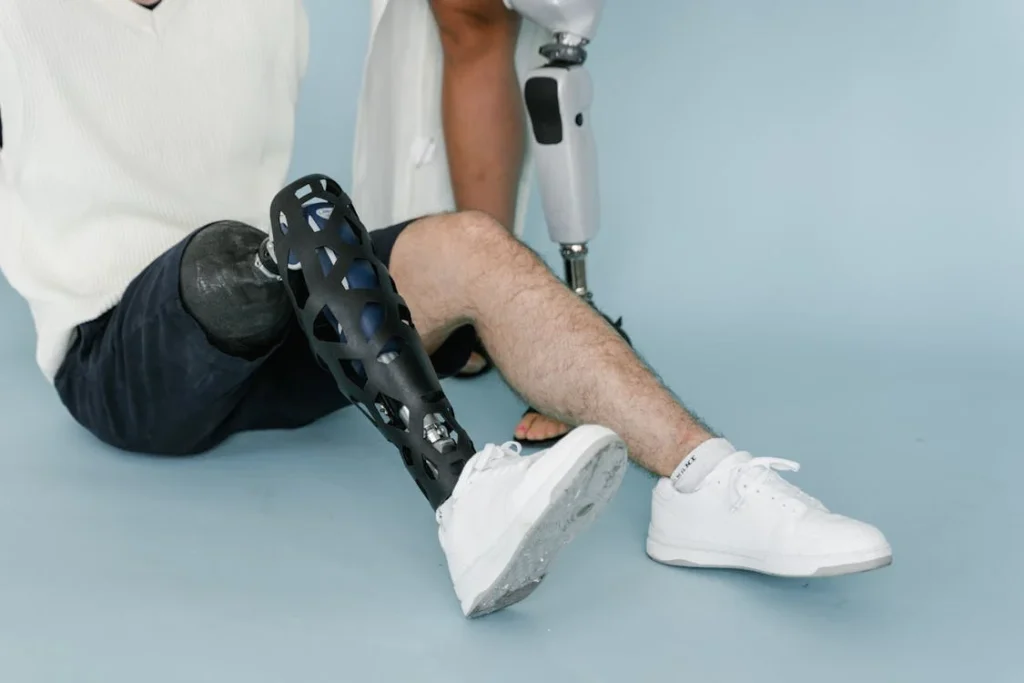Losing a limb is life-changing, but it doesn’t mean you have to give up on sports or an active lifestyle. Many people who use prosthetics take their mobility to the next level by switching to a sports-specific limb. Whether you’re a runner, swimmer, cyclist, or just someone who loves to stay fit, transitioning to a prosthetic designed for sports can open up a world of possibilities.
But making this switch isn’t as simple as replacing one prosthetic with another. It requires careful planning, proper training, and the right mindset. Your body needs time to adjust, and you’ll need to learn how to use the new limb efficiently. That’s why understanding the transition process is crucial.

Understanding the Difference Between a Regular Prosthetic and a Sports-Specific Limb
A regular prosthetic is designed for daily activities like walking, standing, and light movement. It provides stability, comfort, and ease of use, allowing users to go about their routine without much strain.
However, sports put a completely different kind of pressure on the body and the prosthetic. Running, jumping, swimming, or cycling requires specialized movement that a standard prosthetic may not support. That’s where sports-specific prosthetics come in.
Sports prosthetics are engineered to handle intense motion, absorb shock, and provide enhanced control. Unlike regular prosthetics, they are built with advanced materials like carbon fiber to offer better energy return and flexibility.
A running blade, for example, is curved and spring-like, allowing the user to propel forward with more force. A cycling prosthetic, on the other hand, is shaped to maintain grip and control over the bike pedals.
These specialized designs help athletes and active individuals move more naturally and reduce the risk of injury.
Transitioning to a sports prosthetic isn’t just about changing the limb—it’s about learning a whole new way to move. Regular prosthetics distribute weight and force differently, so shifting to a high-performance limb means retraining your body.
The muscles, joints, and even your balance need time to adapt. Many people notice an adjustment period where they feel a bit unsteady or unsure, but with the right approach, this transition can be smooth and successful.
Choosing the Right Sports Prosthetic
Before switching to a sports prosthetic, the first step is selecting the right one for your needs. The best choice depends on the type of activity you want to pursue.
A prosthetic designed for sprinting won’t work the same way for swimming or weightlifting. Each sport requires specific movements, and the prosthetic must complement those actions.
Consulting a prosthetist who specializes in sports prosthetics is crucial. They can assess your activity level, body mechanics, and goals to recommend the best option.
The right fit is not just about comfort—it impacts your performance, safety, and long-term success. If possible, trying out different models through a demo or trial period can help you make an informed decision.
Grippy™, Robobionics’ advanced bionic hand, offers excellent adaptability for sports enthusiasts who require fine motor control. If you’re looking for an upgrade, book a free demo today and experience the difference firsthand.

Preparing Your Body for the Transition
Switching from a regular prosthetic to a sports-specific limb isn’t just about changing equipment—it’s about preparing your body for a new way of moving. Since sports prosthetics are designed for dynamic activities, they demand more from your muscles, joints, and balance.
Your body has already adapted to your everyday prosthetic, and now it will need to adjust again. This process takes time, patience, and the right approach.
One of the first things you’ll notice is the difference in weight distribution. A regular prosthetic is designed for stability and even weight transfer, while a sports prosthetic often enhances motion, meaning your center of gravity may shift.
Your core muscles will play a crucial role in maintaining balance, so strengthening them before making the transition can help. Simple exercises like planks, seated leg lifts, and controlled movements will improve your stability and help you adjust more quickly.
Endurance training is another key factor. A sports prosthetic allows you to move faster, jump higher, or exert more force than a standard limb. However, your body needs to be conditioned to handle this increased intensity.
Gradually increasing your activity level before making the switch can prevent unnecessary strain. If you plan to run, start with longer walks or light jogging with your regular prosthetic before switching to a blade.
If you aim to cycle, practice maintaining balance and posture with your existing limb before trying the specialized prosthetic.
Working with a Rehabilitation Specialist
Rehabilitation is a critical part of the transition process. A specialist can guide you through strength training, movement exercises, and balance drills that will make it easier to adapt to the sports prosthetic.
They can also identify any weaknesses or imbalances that may cause discomfort or injury. Since sports prosthetics engage different muscle groups compared to regular ones, having a structured training plan ensures that your body is prepared.
Many rehabilitation programs today incorporate gamified training, making the learning process more engaging. Robobionics offers home-based rehabilitation programs that use interactive methods to help users adapt to prosthetics faster.
These programs make training fun and effective, reducing the learning curve significantly. If you’re looking for an easy way to transition smoothly, reach out to us and explore how gamified rehabilitation can improve your experience.
Adjusting to the New Sensations
The first time you use a sports prosthetic, it may feel completely different from what you’re used to. Some people describe it as feeling “lighter” or “springier,” while others find it harder to control at first.
Since these prosthetics are designed to enhance movement, they may react more sensitively to shifts in pressure or force.
It’s important to give yourself time to adjust. Walking, running, or even standing with the new limb may feel different at first.
Start with small, controlled movements in a safe environment, such as a gym with a rehabilitation specialist or a space with soft flooring. Practicing basic movements like stepping forward, shifting weight, and bending at the knee will help you gain confidence.

Training for Optimal Performance
Once your body starts adjusting to the sports prosthetic, the next step is training for performance. Unlike a regular prosthetic, which is designed for everyday movements, a sports prosthetic demands precision, speed, and control.
The key to mastering it is consistency in training, focusing on muscle coordination, endurance, and agility.
Many new users find that their first instinct is to use the prosthetic the same way they used their regular limb. However, sports prosthetics work differently.
A running blade, for example, doesn’t have an ankle joint, meaning the movement has to come from the knee and hip. A cycling prosthetic requires a strong grip and rotational control to keep the pedal motion smooth.
Each type has a learning curve, and practicing with the right techniques makes a huge difference.
Working with a coach or physical therapist who understands sports prosthetics can be extremely beneficial. They can help refine your movements and teach you how to engage the correct muscles.
For runners, interval training with short sprints and gradual increases in speed can help build confidence. For swimmers, practicing turns and water resistance exercises will improve movement efficiency.
Strengthening the surrounding muscles will not only help with performance but also prevent injuries.
Overcoming Common Challenges
One of the biggest hurdles in transitioning to a sports prosthetic is overcoming initial discomfort. Even though these prosthetics are designed for performance, they may feel unnatural at first.
Some users experience soreness in their residual limb due to increased pressure. This is normal but should be monitored closely. If pain persists, adjusting the socket fit or cushioning may be necessary.
Balance is another common challenge. Because sports prosthetics are lighter and often designed for speed, they can feel less stable in slow movements.
Practicing balance exercises—such as standing on one leg, shifting weight side to side, or walking on different surfaces—can help improve control. If you’re using a prosthetic for a high-impact sport, strengthening the muscles around the residual limb will improve stability.
Mental adjustments are just as important as physical ones. Some people feel self-conscious when using a sports prosthetic for the first time, especially in public or competitive settings. It’s essential to focus on personal progress rather than comparison.
Confidence grows with time and practice. Many athletes who use prosthetics have faced similar challenges but have gone on to excel in their sport. Finding a community of individuals who share similar experiences can be encouraging and motivating.
Fine-Tuning the Fit for Comfort and Performance
A well-fitted prosthetic is key to both comfort and performance. Unlike a regular prosthetic, which may have a more relaxed fit for everyday wear, a sports prosthetic needs to be snug and secure.
Too loose, and it may cause instability; too tight, and it could lead to discomfort and skin irritation.
Regular check-ins with your prosthetist are necessary, especially in the early stages of using the new limb. Swelling or muscle changes can affect how the socket fits.
Sweat can also be an issue, particularly for high-intensity sports. Using moisture-wicking liners or adjusting the fit with padding can help prevent chafing and discomfort.
If you’re unsure whether your sports prosthetic is fitting correctly, a professional evaluation can help. Robobionics offers personalized consultations to ensure that users get the best possible fit for their needs.
Proper fitment makes a significant difference in performance, so don’t hesitate to seek expert advice.

Building Confidence and Mastering Movement
The transition to a sports prosthetic isn’t just about physical adjustments—it’s also about mental readiness. Many users experience a mix of excitement and uncertainty when they start using their new limb.
The key to success is building confidence through consistent practice and patience.
At first, movements might feel unnatural. If you’re switching to a running blade, the spring-like motion may feel too powerful. If you’re using a cycling prosthetic, maintaining balance and rhythm might take time.
Instead of rushing into full-speed activities, start with slow, controlled movements. Walking, jogging, or practicing weight shifts helps your body get used to the new mechanics.
One of the most effective ways to build confidence is through repetitive motion. The more you practice, the more natural your movements will become.
If you’re running, focus on short distances and gradually increase speed. If you’re lifting weights, concentrate on stability before adding resistance. Small improvements add up over time, and soon, the new prosthetic will feel like an extension of your body.
Another great way to gain confidence is by connecting with other athletes who use sports prosthetics. Many people have gone through the same transition, and their insights can be valuable.
Learning from others’ experiences, whether through online communities or local support groups, can be motivating. Watching professional para-athletes and seeing what’s possible can also inspire you to push your own limits.
Preventing Injuries and Staying Safe
While sports prosthetics enhance mobility and performance, they also introduce new physical demands. It’s important to listen to your body and avoid overexertion.
Injuries often occur when users try to do too much too soon. Gradual progression is key to preventing muscle strain, joint pain, or socket discomfort.
Paying attention to the fit of the prosthetic is one of the best ways to avoid injuries. A poor fit can lead to pressure sores, irritation, or misalignment, which can throw off your movement patterns.
Regularly inspecting your residual limb for signs of redness, swelling, or pain ensures that you catch issues early. If discomfort persists, consulting a prosthetist for adjustments is necessary.
Strength training is also essential for injury prevention. Sports prosthetics rely on different muscle groups than regular ones, so strengthening those muscles reduces strain.
Core stability, leg strength, and flexibility all contribute to better control and movement efficiency. A strong foundation allows you to perform at your best while minimizing the risk of injuries.
Another key aspect of safety is proper warm-ups and cooldowns. Since sports prosthetics encourage high-impact activity, warming up prepares the muscles and joints for movement.
Simple stretching, dynamic drills, and mobility exercises help improve circulation and flexibility. Cooling down afterward helps prevent stiffness and reduces soreness.
Making the Prosthetic a Natural Part of Your Life
As you gain more experience with your sports prosthetic, it will start to feel like a natural part of you. What once seemed challenging will become second nature.
The more you use it, the more control and confidence you’ll develop. Over time, you’ll be able to focus on performance rather than mechanics.
One of the most rewarding parts of using a sports prosthetic is the freedom it provides.
Whether it’s running on a track, cycling through scenic routes, or competing in a sport you love, the right prosthetic allows you to fully engage in your passions. The transition may take time, but every step forward brings new possibilities.
If you’re ready to take the next step toward an active lifestyle, Robobionics is here to help.
From expert consultations to advanced prosthetic technology, we provide the tools and support you need to make your transition successful. Book a free demo of Grippy™ today and experience the difference a high-performance prosthetic can make in your journey.

The Psychological Shift: Adapting to a New Way of Movement
Switching to a sports prosthetic isn’t just a physical journey—it’s a mental one as well. The way you perceive movement, balance, and even your own capabilities will change.
Many people don’t realize how much of their athletic ability is tied to confidence, mindset, and adaptability. The right mental approach can make the transition smoother and more fulfilling.
Breaking Through Mental Barriers
A common challenge in transitioning to a sports prosthetic is overcoming self-doubt. Since a sports limb functions differently than a regular one, there’s often a learning curve that can be frustrating at first.
You might feel unsteady, slow, or even awkward. This is completely normal, but the key is persistence. The more you practice, the more natural your movements will feel.
Fear of failure can also hold you back. Many first-time users hesitate to push themselves because they’re worried about falling or making mistakes. However, every athlete—regardless of ability—faces setbacks.
The best way to improve is to embrace challenges as part of the process. If you stumble or struggle, see it as a learning opportunity rather than a limitation.
Developing Muscle Memory and Reflexes
A big part of adapting to a sports prosthetic is retraining your brain to work with it instinctively. With a regular prosthetic, you’ve likely developed movement patterns that work for everyday tasks.
But in sports, your body needs to respond quickly and efficiently, which means building new muscle memory.
Repetitive training helps your brain and body sync up. If you’re learning to run, for example, your brain needs to recognize the motion of the blade and adjust your stride.
If you’re cycling, your reflexes must adapt to the new connection between the limb and the pedal. The more you repeat these movements, the faster your body will adapt.
Visualization techniques can also help. Many athletes mentally rehearse their movements before performing them. Picture yourself running smoothly, maintaining balance, or making quick turns.
This practice strengthens the neural connections that control movement, making real-life execution easier.
Overcoming Social and Emotional Challenges
For some people, using a sports prosthetic in public or competitive environments can bring a mix of emotions.
There might be concerns about how others perceive the limb or self-consciousness about looking different. It’s important to shift the focus from external opinions to personal progress.
Surrounding yourself with supportive people makes a huge difference. Training with other athletes, joining a community of prosthetic users, or even just having a strong personal support system can boost confidence.
Many adaptive sports groups offer mentorship and guidance, providing a space to connect with others who understand the journey.
Setting small, achievable goals also helps build confidence. Instead of focusing on mastering everything at once, break it down into milestones.
Whether it’s running a short distance without stopping, completing a full cycling session, or improving balance, every accomplishment adds to your progress.
The Reward of Pushing Past Limits
One of the most empowering moments in the transition to a sports prosthetic is the realization that you’re capable of more than you thought.
The challenges along the way make the victories even more meaningful. Whether it’s feeling the rush of sprinting at full speed, making a smooth transition in a triathlon, or simply enjoying movement without hesitation, the reward is worth the effort.
The journey doesn’t stop once you’ve adapted. As you gain experience, you’ll find new ways to refine your performance, push past limits, and explore new possibilities. Your sports prosthetic isn’t just a tool—it’s a gateway to a more active, fulfilling life.
If you’re ready to take control of your mobility and performance, Robobionics is here to help. We offer cutting-edge prosthetic solutions, expert guidance, and a commitment to empowering every user.
Book a free consultation today and take the next step in your journey toward athletic excellence.

Customization and Technology: Making the Prosthetic Work for You
Every athlete is different, and so is every prosthetic. One of the most exciting aspects of sports prosthetics is the ability to customize them to match your specific needs.
Unlike regular prosthetics, which follow a more standardized design for daily use, sports prosthetics can be fine-tuned for performance, comfort, and efficiency.
Understanding the Role of Technology in Sports Prosthetics
Advancements in prosthetic technology have revolutionized sports for people with limb differences. Modern sports prosthetics use lightweight, high-performance materials like carbon fiber, which offer better energy return and durability.
The design of each limb is tailored to specific activities—whether it’s a running blade that mimics the elasticity of tendons or a swimming prosthetic that reduces drag in water.
Microprocessor-controlled joints are another breakthrough, especially for above-knee amputees. These advanced systems adjust movement in real-time, making transitions smoother and more natural.
For example, a microprocessor knee can detect changes in walking speed and terrain, automatically adjusting resistance for better stability. This allows users to move more efficiently with less effort.
Even upper-limb prosthetics, like the Grippy™ bionic hand by Robobionics, integrate advanced sensor technology that improves grip strength and control.
Athletes in sports like rock climbing, weightlifting, or adaptive CrossFit benefit from prosthetic hands that respond quickly to their movements. If you’re considering a high-tech solution, book a free demo of Grippy™ to see how advanced prosthetics can enhance your performance.
The Importance of a Customized Fit
Customization is critical for both comfort and function. Unlike daily-use prosthetics, which prioritize long-term wearability, sports prosthetics need to be optimized for high-intensity movement.
A running blade, for example, needs to match the user’s weight, running style, and impact level to provide the right amount of spring and stability.
Socket fit is one of the most important elements of customization. If the socket is too loose, it can cause instability, while a too-tight fit can lead to discomfort or skin irritation.
Many athletes use custom-molded sockets designed to accommodate their residual limb’s shape and movement patterns. Some even have adjustable suspension systems that allow for minor tweaks based on activity level.
Liner materials also play a role in performance. Some sports prosthetic users prefer silicone liners for extra grip and durability, while others opt for gel liners for added comfort.
Sweat management is another factor—since intense activity increases perspiration, some prosthetic systems include moisture-wicking liners or built-in cooling mechanisms.
Adapting the Prosthetic to Different Conditions
Sports prosthetics aren’t just designed for a single environment—they can be adapted for various conditions. Runners, for example, might have different blades for sprinting versus long-distance running.
Swimmers may use specialized waterproof prosthetics with flexible joints for better propulsion in the water. Adaptive skiers and snowboarders rely on shock-absorbing components to handle rough terrain.
Even weather conditions can affect performance. Running blades, for instance, may require adjustments for traction on wet surfaces. Cyclists might need a different attachment to improve pedal grip in slippery conditions.
Understanding how your prosthetic interacts with different surfaces and temperatures allows you to optimize performance and avoid unnecessary wear and tear.
The Future of Sports Prosthetics
Technology is constantly evolving, and the future of sports prosthetics is full of exciting possibilities. Researchers are working on powered prosthetics with built-in actuators that mimic muscle function, allowing for more precise and natural movement.
3D printing is also making customization more accessible, enabling athletes to get tailor-made prosthetics faster and at a lower cost.
The rise of smart prosthetics is another game-changer. Some modern designs include sensors that provide real-time feedback on movement patterns, helping athletes fine-tune their technique.
AI-driven systems can analyze gait, adjust energy return, and even predict fatigue levels to reduce injury risk.
Robobionics stays at the forefront of these advancements, ensuring that users get access to the latest innovations.
If you’re curious about how technology can enhance your prosthetic experience, reach out to us for expert guidance on choosing the right sports prosthetic for your needs.
Conclusion
Transitioning from a regular prosthetic to a sports-specific limb is a journey that requires patience, training, and the right mindset. It’s not just about switching equipment—it’s about learning new movement patterns, building strength, and gaining confidence. While the process comes with challenges, the rewards are life-changing. Whether you’re running your first sprint, cycling with precision, or excelling in adaptive sports, a well-fitted sports prosthetic opens doors to limitless possibilities.
With advancements in prosthetic technology and customized solutions, athletes today have more opportunities than ever to push their limits. At Robobionics, we are committed to empowering individuals with cutting-edge prosthetic solutions, expert guidance, and gamified rehabilitation programs that make adaptation easier.
If you’re ready to take the next step in your athletic journey, we’re here to help. Book a free demo of Grippy™ or schedule a consultation to find the perfect sports prosthetic for you. The road to peak performance starts with the right support—and we’ll be with you every step of the way.



